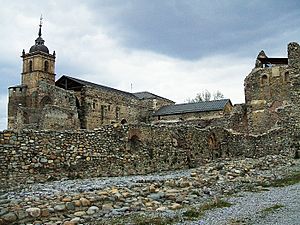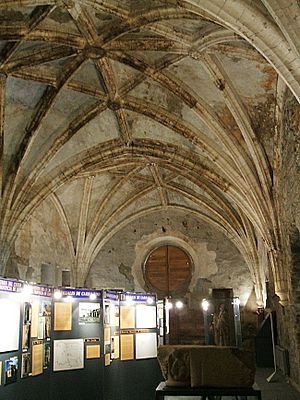Monastery of Carracedo facts for kids
The Monastery of Saint Mary of Carracedo (also known as the Monasterio de Santa María de Carracedo) is an old monastery and palace in Spain. It is located near the town of Carracedelo in the province of León. This special place was started in the 900s by the Benedictine order of monks. It is also close to the famous Way of Santiago, a historic walking path in Northern Spain. Today, it is no longer active but is being restored.
Contents
History of the Monastery
A Home for Monks
The first group of monks settled here around the year 990. This community was called the Monastery of San Salvador. It was founded by Bermudo II, who was the King of León and Galicia. The main reason for building it was to give shelter to monks. They needed a safe place because of attacks from a Moorish general named Almanzor. However, even with this purpose, Almanzor's army destroyed the monastery in 997.
Rebuilding and New Orders
Many years later, in 1138, a princess named Sancha helped rebuild the monastery. She was the sister of King Alfonso VII of León. Princess Sancha asked monks from a nearby monastery to help her. The monastery grew and became very important, gaining control of lands. It even had a royal palace where important people stayed.
In 1203, the monks at Carracedo changed their religious order. They joined the Cistercian order, which was connected to the Cîteaux in France. From then on, it was known as the Monasterio de Santa María de Carracedo. The monastery faced more damage during the Napoleonic wars. Finally, it was closed down in 1835.
Architecture and Heritage
The Monastery of Saint Mary of Carracedo is now a historic site. It is listed on the Spanish heritage register as a Bien de Interés Cultural (BIC). This means it is a very important cultural site. It was declared a National Historic-Artistic Monument in 1929.
The monastery's rooms and cloisters are no longer used, but they show different building styles from over the centuries. You can see Romanesque, Gothic, and Neoclassical styles. These styles come from different periods when parts of the monastery were built or changed. The stone buildings are not heavily decorated, giving them a quiet and empty feeling.
See also




